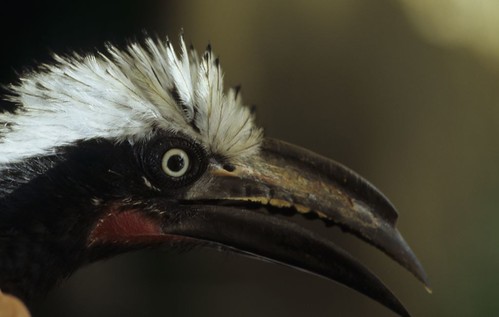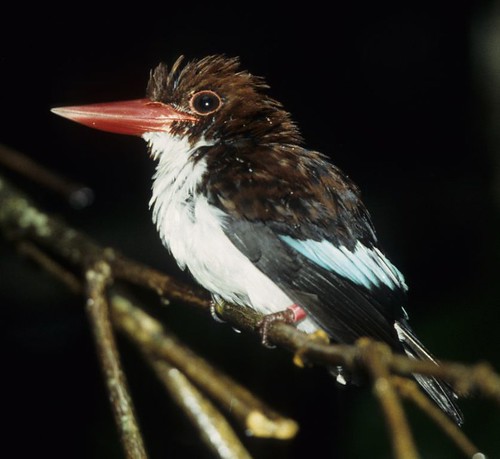tags: researchblogging.org, global warming, climate change, ornithology, birds, avian biodiversity, habitat destruction
White-crested hornbill, Tropicranus albocristatus, also confined to African rainforests, may see more than half of its geographic range lost by 2100.
Image: Walter Jetz, UCSD. [larger]
Thanks to the combined effects of global warming and habitat destruction, bird populations will experience significant declines and extinctions over the next century, according to a study conducted by ecologists at the University of California, San Diego and Princeton University. This study, published in the online open-access journal, PLoS Biology, warns that, even under the most optimistic scenarios where climate change is controlled and habitats are protected, at least 400 bird species will become endangered or go extinct by 2050 due to reductions of greater than 50 percent in their geographic ranges. The estimates are in line with those from a similar study published last year in The Proceedings of the National Academy of Sciences.
"We found in our study that under certain assumptions by the year 2100, 950 to 1,800 bird species may be imperiled or even driven to extinction by climate change and habitat destruction," said Walter Jetz, an assistant professor of biological sciences at UCSD and lead author of the study. "Most of these species are currently not recognized as imperiled."
According to their predictions, the white-crested hornbill (pictured, top) and almost 1,000 other species may lose more than half of their natural ranges. More than 50 of those species could end up extinct. There are approximately 8,750 bird species in the world.
Already, climate change and deforestation have played a role in extinctions and geographical range reductions of many terrestrial species of vertebrate animals in recent decades. But this loss of diversity appears to be accelerating based on predictions of future projections of global warming and deforestation.
In the study, the authors combined information from four projections of future global warming, agricultural expansion and human population growth from the global Millennium Ecosystem Assessment (MEA) with current geographic ranges of the world's 8,750 species of terrestrial birds. They overlaid the birds' ranges on the MEA's vegetation maps, and measured the change in vegetation over each bird's range. They used these data to estimate the impact of climate and land use changes on the birds. All estimates used in the study were based on the assumption that birds will not dramatically shift their geographic ranges in response to a changing climate.
They found that those losses were dramatic. In the most optimistic scenario, they found that 16% of the earth's land had been transformed due to climate change and 9% due to habitat destruction. In the least optimistic scenario, one where little proactive environmental planning took place, habitat loss in tropical regions was nearly twice as high. Using these data, Jetz and his colleagues predicted that the number of threatened bird species would increase by 19-30% by 2050, and 29-52% by 2100.
"The most intense climate change is expected at higher latitudes, where birds are relatively species-poor and have large ranges," said Jetz. "Dramatic levels of deforestation and other forms of land conversion are projected to continue or even increase in much of the tropics. There birds and most other taxonomic groups are especially diverse and tend to have small ranges, making them particularly vulnerable to extinction."
Predictably, more bird species may end up imperiled by deforestation in the near future than due to climate change.
"This is akin to killing two birds with one stone," said co-author David Wilcove without a trace of irony. Wilcove is a professor at Princeton. "Deforestation drives tropical species to extinction and also contributes to global climate change. Climate change, in turn, drives temperate species to extinction. The good news is that by halting deforestation we can protect both tropical and temperate birds."
The authors hope that their report will serve as a warning that the age-old problems of deforestation and land conversion are still critical to the long-term survival of birds and other animals. They say that a vastly expanded network of wildlife reserves in the tropics, combined with more ambitious goals to reduce greenhouse gas emissions along with careful monitoring of the biodiversity impacts of climate change will be essential to minimize global extinctions.
"These hundreds of bird species headed toward extinction are like thousands of dying canaries in coal mines," added Andrew Dobson, the third author of the paper and a professor of ecology and evolutionary biology at Princeton. "It's time we paid attention to them."
The study is an excellent attempt to integrate land use and climate change, said Stanford University ecologist Terry Root, who was not a co-author on the study. But given the inherent uncertainty of long-term models, Root urges caution before reading too much into the hard numbers. However, "[w]e need to take what they've said very seriously, if not completely literally," she warned. "I think what this is saying is that we are in trouble, and I think we are."
Chocolate-backed kingfisher, confined to African rainforests, may see more than half of its geographic range lost by 2100.
Image: Walter Jetz, UCSD. [larger]
Sources
Jetz, W., Wilcove, D.S., Dobson, A.P. (2007). Projected Impacts of Climate and Land-Use Change on the Global Diversity of Birds. PLoS Biology, 5(6), e157. DOI: 10.1371/journal.pbio.0050157 [text and PDF]
Press release (quotes)
- Log in to post comments



We really have made a mess of the planet and it doesn't seem to be getting better. Ah well, just have to do what little I can to make it better.